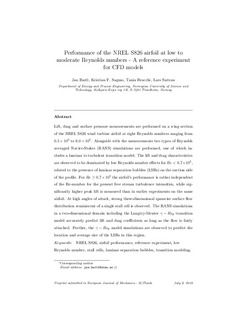| dc.contributor.author | Bartl, Jan Michael Simon | |
| dc.contributor.author | Sagmo, Kristian Forfot | |
| dc.contributor.author | Bracchi, Tania | |
| dc.contributor.author | Sætran, Lars Roar | |
| dc.date.accessioned | 2019-03-05T14:25:50Z | |
| dc.date.available | 2019-03-05T14:25:50Z | |
| dc.date.created | 2018-10-30T11:44:59Z | |
| dc.date.issued | 2019 | |
| dc.identifier.citation | European journal of mechanics. B, Fluids. 2019, 75 180-192. | nb_NO |
| dc.identifier.issn | 0997-7546 | |
| dc.identifier.uri | http://hdl.handle.net/11250/2588842 | |
| dc.description.abstract | Lift, drag and surface pressure measurements are performed on a wing section
of the NREL S826 wind turbine airfoil at eight Reynolds numbers ranging from
0:5_105 to 6:0_105. Alongside with the measurements two types of Reynolds
averaged Navier-Stokes (RANS) simulations are performed, one of which in-
cludes a laminar to turbulent transition model. The lift and drag characteristics
are observed to be dominated by low Reynolds number e_ects for Re < 0:7_105,
related to the presence of laminar separation bubbles (LSBs) on the suction side
of the pro_le. For Re _ 0:7_105 the airfoil's performance is rather independent
of the Re-number for the present free stream turbulence intensities, while sig-
ni_cantly higher peak lift is measured than in earlier experiments on the same
airfoil. At high angles of attack, strong three-dimensional spanwise surface ow
distribution reminiscent of a single stall cell is observed. The RANS simulations
in a two-dimensional domain including the Langtry-Menter ����� Re_ transition
model accurately predict lift and drag coe_cients as long as the ow is fairly
attached. Further, the ����� Re_ model simulations are observed to predict the
location and average size of the LSBs in this region. | nb_NO |
| dc.language.iso | eng | nb_NO |
| dc.publisher | Elsevier | nb_NO |
| dc.rights | Attribution-NonCommercial-NoDerivatives 4.0 Internasjonal | * |
| dc.rights | Attribution-NonCommercial-NoDerivatives 4.0 Internasjonal | * |
| dc.rights.uri | http://creativecommons.org/licenses/by-nc-nd/4.0/deed.no | * |
| dc.title | Performance of the NREL S826 airfoil at low to moderate Reynolds numbers — A reference experiment for CFD models | nb_NO |
| dc.type | Journal article | nb_NO |
| dc.type | Peer reviewed | nb_NO |
| dc.description.version | acceptedVersion | nb_NO |
| dc.source.pagenumber | 180-192 | nb_NO |
| dc.source.volume | 75 | nb_NO |
| dc.source.journal | European journal of mechanics. B, Fluids | nb_NO |
| dc.identifier.doi | 10.1016/j.euromechflu.2018.10.002 | |
| dc.identifier.cristin | 1624878 | |
| dc.description.localcode | © 2018. This is the authors’ accepted and refereed manuscript to the article. Locked until 9 October 2020 due to copyright restrictions. This manuscript version is made available under the CC-BY-NC-ND 4.0 license http://creativecommons.org/licenses/by-nc-nd/4.0/ | nb_NO |
| cristin.unitcode | 194,64,25,0 | |
| cristin.unitname | Institutt for energi- og prosessteknikk | |
| cristin.ispublished | true | |
| cristin.fulltext | postprint | |
| cristin.qualitycode | 1 | |

